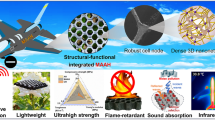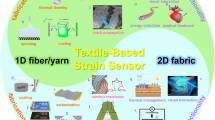Abstract
Carbon nanotubes with bridged boundary conditions are widely used in the design of nano-sensors and oscillators. However, defects are inseparable from the carbon nanotubes which can affect its dynamics behavior and sensing performance. Influence of hexa-vacancy defect in terms of their numbers and migration along the length of the bridged single-walled carbon nanotube (SWCNT) is investigated through MD simulations. Moreover, effects of geometric parameters like length, diameter and chirality are studied for pristine SWCNT under bridged boundary condition. Effects of these aspects on free vibration response of SWCNT are studied through change in principal natural frequencies. It is observed that effect on the natural frequency get enhanced with increase in numbers of vacancy defect. Vibration characteristics of bridged SWCNT are less affected by the vacancy defect placed at mid-portion of the tube length. It is also found that shorter and thicker SWCNT offer higher vibrational sensitivity. Effect of chirality becomes less pronounced for longer tubes. The results of this study provide valuable input in the design of SWCNT-based nano-sensors.








Similar content being viewed by others
References
S. Iijima, Helical microtubules of graphitic carbon. Nature 345, 56–58 (1991)
S.J. Papadakis, A.R. Hall, P.A. Williams, L. Vicci, M.R. Falvo, R. Superfine et al., Resonant oscillator with carbon nanotube torsion springs. Phys. Rev. Lett. 93, 146101–146104 (2004)
Q. Zhao, Z. Gan, Q. Zhuang, Electrochemical sensors based on carbon nanotubes. Electroanalysis 14, 23 (2002)
W.D. Yang, X. Wang, C.Q. Fang, G. Lu, Electromechanical coupling characteristics of carbon nanotube reinforced cantilever nano-actuator. Sens. Actuat. A Phys. 220(1), 178–187 (2014)
B. Arash, J.-W. Jiang, T. Rabczuk, A review on nanomechanical resonators and their applications in sensors and molecular transportation. Appl. Phys. Rev. 2(2), 021301 (2015)
Q. Zheng, Q. Jiang, Multiwalled carbon nanotubes as gigahertz oscillators. Phys. Rev. Lett. 88, 045503 (2000)
P. Poncharal, Z.L. Wang, D. Ugarte, W.A. deHeer, Electrostatic deflections and electromechanical resonances of carbon nanotubes. Science 283(5407), 1513–1516 (1999)
C.Y. Li, T.W. Chou, Single-walled carbon nanotubes as ultrahigh frequency nanomechanical resonators. Phys. Rev. B 68, 073405 (2003)
C.Y. Li, T.W. Chou, Vibrational behaviors of multiwalled-carbon-nanotube-based nanomechanical resonators. Appl. Phys. Lett. 84, 121–123 (2003)
C.Y. Li, T.W. Chou, Strain and pressure sensing using single-walled carbon nanotubes. Nanotechnology 15, 1493–1496 (2004)
P. Hauptmann, Resonant sensors and applications. Sens. Actuat. A Phys. 26, 371–377 (1991)
R.F. Gibson, E.O. Ayorinde, Y.F. Wen, Vibrations of carbon nanotubes and their composites: a review. Compos. Sci. Technol. 67(1), 1–28 (2007)
H.B. Peng, C.W. Chang, S. Aloni, T.D. Yuzvinsky, A. Zettl, Ultrahigh frequency nanotube resonators. Phys. Rev. Lett. 97, 087203 (2006)
B. Lassagne, D. Garcia-Sanchez, A. Aguasc, Ultrasensitive mass sensing with a nanotube electro-mechanical resonator. Nano Lett. 8(11), 3735–3738 (2008)
R. Mateiu, A. Kühle, R. Marie, A. Boisen, Building a multi-walled carbon nanotube-based mass sensor with the atomic force microscope. Ultramicroscopy 105(1), 233–237 (2005)
J. Yoon, C.Q. Ru, A. Mioduchowski, Vibration of an embedded multiwall carbon nanotube. Compos. Sci. Technol. 63, 1533–1542 (2003)
C.M. Wang, V.B.C. Tan, Y.Y. Zhang, Timoshenko beam model for vibration analysis of multi-walled carbon nanotubes. J. Sound Vib. 294, 1060–1072 (2006)
J.N. Reddy, S.D. Pang, Nonlocal continuum theories of beams for the analysis of carbon nanotubes. J. Appl. Phys. 103, 023511 (2008)
A.Y. Joshi, S.C. Sharma, S.P. Harsha, Zeptogram scale mass sensing using single walled carbon nanotube based biosensors. Sens. Actuat. A Phys. 168(2), 275–280 (2011)
G.X. Cao, X. Chen, J.W. Kysar, Strain sensing of carbon nanotubes: numerical analysis of the vibrational frequency of deformed sing-wall carbon nanotubes. Phys. Rev. B 72, 195412 (2005)
N. Yao, V. Lordi, Young’s modulus of single-walled carbon nanotubes. J. Appl. Phys. 84, 1939–1943 (1998)
Y.Y. Zhang, C.M. Wang, V.B.C. Tan, Assessment of Timoshenko beam models for vibrational behaviour of single-walled carbon nanotubes using molecular dynamics. Adv. Appl. Math. Mech. 1(1), 89–106 (2009)
W.H. Duan, C.M. Wang, Y.Y. Zhang, Calibration of nonlocal scaling effect parameter for free vibration ofcarbon nanotubes by molecular dynamics. J. Appl. Phys. 101, 024305 (2007)
R. Ansari, S. Ajori, B. Arash, Vibrations of single- and double-walled carbon nanotubes with layer-wiseboundary conditions: a molecular dynamics study. Curr. Appl. Phys. 12, 707–711 (2012)
T.W. Ebbesen, T. Takada, Topological and SP3 defect structures in nanotubes. Carbon 33(7), 973–978 (1995)
A.Y. Joshi, S.C. Sharma, S.P. Harsha, Effect of chirality and atomic vacancies on dynamics of nanoresonators based on SWCNT. Sens. Rev. 31(1), 47–57 (2011)
A.Y. Joshi, S.C. Sharma, S.P. Harsha, The effect of pinhole defect on vibrational characteristics of single walled carbon nanotube. Physica E 43(5), 1040–1045 (2011)
A. Ghavamian, A. Ochsner, Numerical modeling of Eigen modes and Eigen frequencies of single and multi-walled carbon nanotubes under the influence of atomic defects. Comput. Mater. Sci. 72, 42–48 (2013)
V. Parvaneh, M. Shariati, H. Torabi, Frequency analysis of perfect and defective SWCNTs. Comput. Mater. Sci. 50(7), 2051–2056 (2011)
S.K. Georgantzinos, G.I. Giannopoulos, N.K. Anifantis, The effect of atom vacancy defect on the vibrational behavior of single-walled carbon nanotubes, in A Structural Mechanics Approach. Advances in Mechanical Engineering, Article ID 291645 (2014)
A.A. Shariati, A.R. Golkarian, M. Jabbarzadeh, Investigation of vibrational behavior of perfect and defective carbon nanotubes using non-linear mass–spring model. J. Solid Mech. 6(3), 255–264 (2014)
L.J. Chen, Q. Zhao, Z. Gong, The effects of different defects on vibration properties of single- walled carbon nanotubes. Adv. Mater. Res. 225–226, 1133–1136 (2011)
M. Goel, S.P. Harsha, M.P. Mishra, R.K. Mishra, Buckling failure analysis of defective carbon nanotubes using molecular dynamics simulation (Anal. Prev., J Fail, 2020). https://doi.org/10.1007/s11668-020-00886-x
M. Goel, S.P. Harsha, S. Singh, A.K. Sahani, Analysis of temperature, helicity and size effect on the mechanical properties of carbon nanotubes using molecular dynamics simulation (Today Proc, Mater, 2020). https://doi.org/10.1016/j.matpr.2020.01.130
S.J. Stuart, A.B. Tutein, J.A. Harrison, A reactive potential for hydrocarbons with intermolecular interactions. J. Chem. Phys. 112, 6472–6486 (2000)
W.G. Hoover, Canonical dynamics: equilibrium phase-space distributions. Phys. Rev. A 31, 1695–1697 (1985)
S. Noose, A unified formulation of the constant temperature molecular dynamics methods. J. Chem. Phys. 81, 511–519 (1984)
L. Verlet, Computer “experiments” on classical fluids. I. Thermodynamica properties of Lennard-Jones molecules. Phys. Rev. 159, 98–103 (1967)
Author information
Authors and Affiliations
Corresponding author
Ethics declarations
Conflict of interest
The authors declare that they have no known competing financial interests or personal relationships that could have appeared to influence the work reported in this paper.
Additional information
Publisher's Note
Springer Nature remains neutral with regard to jurisdictional claims in published maps and institutional affiliations.
Rights and permissions
About this article
Cite this article
Goel, M., Harsha, S.P., Mishra, M.P. et al. Effect of Geometrical Parameters and Hexa-Vacancy Defects on Vibration Characteristics of Bridged Carbon Nanotube. J Fail. Anal. and Preven. 20, 1875–1883 (2020). https://doi.org/10.1007/s11668-020-01001-w
Received:
Accepted:
Published:
Issue Date:
DOI: https://doi.org/10.1007/s11668-020-01001-w




